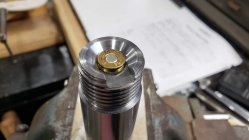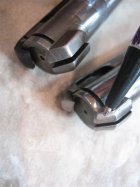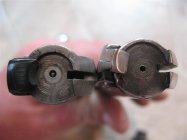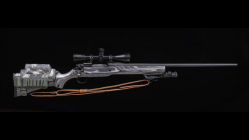That's actually an entirely different action. Your Mk 4 is a rear lug action. The M1917 has more in common with a Mauser 98 than the SMLE. The 1917 does have a M1914 counterpart that was produced in .303 for England
Heck I got curious an had to go to the safe and look -- mine is a Number 4, Mark 1.. How the hell is anyone sposed to remember this stuff.

jd
Not only two (very) different rifles and actions, but different periods and wars.
The original UK Lee rifles went back to the 1880s, first in long barrel form with initially Metford Rifling, then with the move to Cordite loaded ammunition, the deeper-groove Enfield form (hence Lee-Enfield). As was common worldwide there was a long infantry rifle and a short-barrel cavalry carbine. It was this series that was mostly used by British Empire troops in the second Boer War (1899-1902) against Afrikaaner 'Boer' white settlers/farmers in South Africa. The Boer militiamen used 7X57mm M1895 Mausers primarily as mounted infantry and such was their riding, fieldcraft and shooting skills (allied to the very accurate Mauser rifle and cartridge) that initially at least the Empire forces came off worst.
Post Boer War the British War Office and ordnance departments developed a single short 'universal' rifle, the SMLE that covered all military roles - infantry, cavalry, artillerymen, engineers, bicycle troops etc, the original adopted in 1903 and by WW1 developed through various improvements to the Mk III version.
The SMLE Mk III (later renamed Rifle No.1 MK3) was the best battle rifle of the period, but various parties hated it and used the British Army's performance in the Boer War with its older LLE version to rubbish it. There was constant lobbying to change to a Mauser type front-locking action design with a high-performance flat-shooting 7mm cartridge. (But not the Mauser / Boer 7X57 - it had to have a bigger case, hotter propellant and higher MV.) Such a rifle and cartridge were developed until 1912 and were semi-adopted as a troop-trials rifle in 1913. Using an older nomenclature system this was named the Pattern of 1913 model, or P'13. Troop trials didn't go well for various reasons, mostly because a far too high-pressure cartridge loading was adopted (the .276 Enfield cartridge), but problems would likely have been solved and the rifle / cartridge eventually replace the SMLE and .303 MkVII cartridge. However, the outbreak of war in 1914 killed that off and the British Empire went war with the SMLE Mk III (except Canada which had adopted a home-grown service rifle, the straight-pull Ross Mk III).
Not long into the war and Enfield Lock and BSA who manufactured SMLEs couldn't make nearly enough to supply a massively growing army and replace losses in combat. So, the British Government went to arms companies in the USA and said please bid to make them for us. No go! RSAF Enfield Lock developed rifles were made and checked using patterns and gauges, not toleranced drawings which American industry needed. As the P'13 had such, Remington (I think) agreed to redesign the 276 P'13 to feed and chamber the 0.303" round and Winchester, Remington Eddystone, and Remington Ilion were contracted to make the new version, named the Pattern 1914, or P'14 as everybody calls it. Eventually in late 1916, early 1917 the Brits had enough rifles and terminated the P'14 contracts throwing three factories out of work.
However, shortly afterwards the USA entered the war and lo and behold its army didn't have enough M1903s and Springfield and Rock Island Armories couldn't make them fast enough to supply a massively growing army ....... etc, etc. So the US government asked Remington to redesign the rifle for a second time to accept and feed the .30-06 ball round. Again renamed, you have the US Model of 1917 (M1917) made in the same three American factories until the end of WW1 when the US Govt contracts were terminated.
Between the wars, neither country had any money for the military so most everything froze as per 1918 with little development, at least in infantry weapons. British Ordnance looked closely at the SMLE and drew up a list of faults, primarily a very light, thin barrel that overheated in rapid fire and a too light receiver with weak sidewalls. Along with other improvements such as a receiver mounted aperture rear sight, a new model was developed, tested and named the No.4 Rifle. There was no money to re-equip the British forces so the design sat on the shelf and none were made after the limited number manufactured for troop trials. Come 1939 and the Army was massively expanded and there was nothing like enough production capacity (plus RSAF Enfield Lock switched over entirely to making BREN LMGs) ........ and you know the old story! So, as well as three new English arms factories being built and lots of components outsourced to repurposed consumer manufacturers (like the Singer Sewing Machine Co. in Scotland making rearsight assemblies), manufacture was again contracted out to North America to supplement domestic production. The production rifle was called the Rifle No.4 Mk1 and was made by the Canadian Long Branch arsenal and Savage Arms at Chickopee Falls, Mass as well as in England. It is the best of the Lee series in terms of strength, function and accuracy, but lacks the iconic looks of the older SMLE and its super-smooth quick-working action.
Post WW2, and especially post 1957 when the Brits adopted a version of the FN FAL 7.62 rifle, millions came onto the surplus market. Many went to Asian governments especially India (where there are probably some racked even today in rural police stations), the new state of Israel and so on. Others went into private hands worldwide both to recreational military rifle shooters and deerstalkers (deer hunters to you) in sporterised form. In fact, 'tuned' No.4s were the backbone of British and British Commonwealth formal long-range target sling-shooting until 1967/8 when custom single-shot 7.62mm / 308 'Target Rifles' replaced the old 303s on Bisley and other ranges.
In the UK and Canada, the P'14 model followed a similar course - mothballed in 1919 as a secondary weapon, reissued in 1939 (in some cases as sniper rifles due to their inherent accuracy). There was a wrinkle in that with the USA neutral in 1939/40 and Britain desperately short of rifles (again!!), thousands of M1917s were taken out of store and supplied to the Brits by the US Government under the Lend-Lease Acts. This meant that there were two outwardly identical rifles with different chamberings issued to second-line units. To differentiate them, the M1917s had red stripes painted around the forends and buttstocks. Many (of both types) went to the Home Guard, a part-time militia intended to assist the regular forces in the event of German invasion of the British Isles. Post 1945, as per the No.4s - sold to other countries or on the surplus markets and used by UK target shooters in both .303 and rebuilt as 7.62 'Target Rifles' in the 1st Gen 'TR' rifles in 1968. Or sporterised as per the subject of this topic. IME, if well done they are far superior to the No.4 sporting rifle conversions. Also the P'14 receiver is long and strong enough to handle large belted African Dangerous Game cartridges. and no change is needed to the P'14 bolt-face for 'magnums'. Art Alphin (A-Square) built several of his African rifles on this action, mostly the cheaper models in his catalogue.














